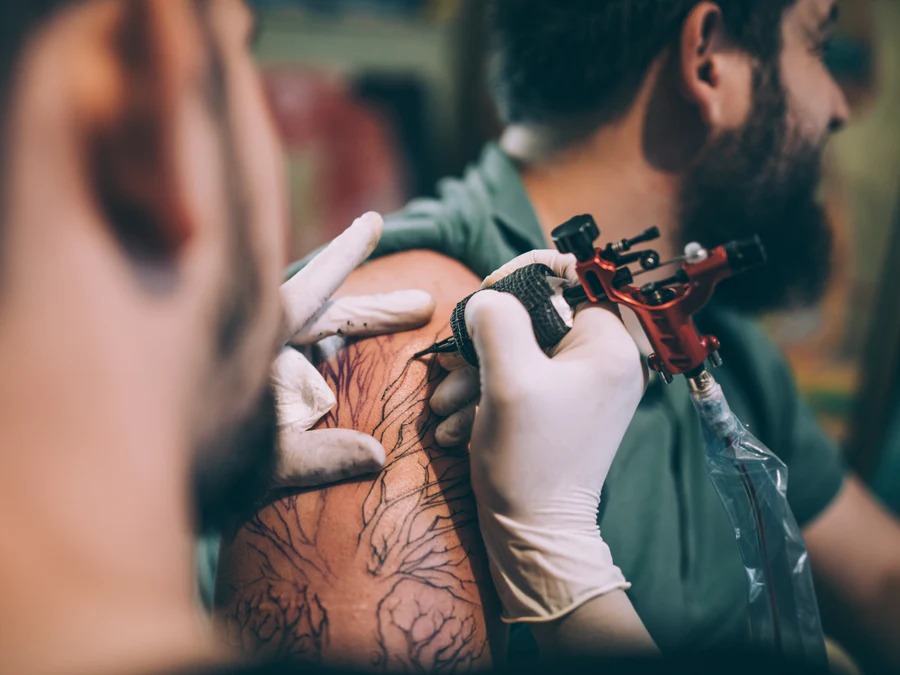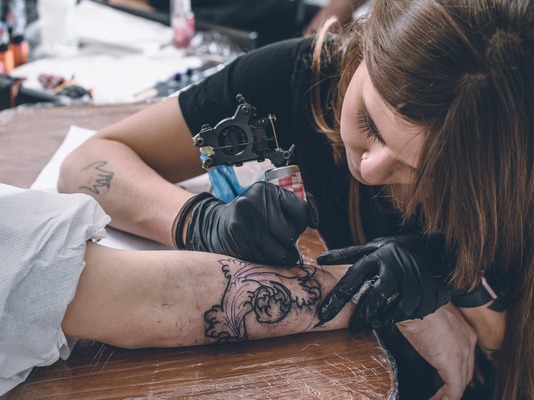Getting a tattoo is a big commitment, involving careful design and artist selection, plus enduring the needle. However, the real journey is the healing process. So, how long do tattoos take to heal? Some methods can speed it up, while others slow it down. If you’re worried about your tattoo healing in time for an event or its proper healing, don’t stress. I’ll guide you through the entire tattoo healing process and more.
Tattoo Healing – A Complete Timeline-The Answer
[su_note radius=”6″]Tattoo healing takes 2-3 weeks for the outer layer and up to 6 months overall. Initially, keep it covered, clean thrice daily, and moisturize. Pain decreases by day 3, with peeling starting; by week 2, the outer skin heals. Healing varies by tattoo location, size, and color—speed recovery by cleaning, moisturizing, wearing loose clothes, and avoiding sun and pools.[/su_note]

Tattoo Healing Stages – A Complete Timeline
Getting a new tattoo is exciting, but understanding the healing process is crucial. The outer layer of your tattoo will heal within 2-3 weeks, though the entire process often takes upwards of 6 months. Initially, the healing timeline may seem long, but knowing what to expect helps. The deeper layers continue to recover, ensuring your tattoo looks its best.
The First 24-48 Hours
During the critical first 48 hours post-tattoo, cover it for 4-6 hours and expect initial redness and oozing. As inflammation increases by the second day, keep the area clean with unscented soap and warm water, avoiding tight clothing—especially crucial for detailed New School tattoos.
- Keep the area covered for 4-6 hours
- Expect redness and oozing
- Clean 3 times a day
- Moisturize after 24 hours and continue twice a day
Days 3-7
By day 3, pain should decrease, but plasma might still ooze for 6-7 days. The area will remain red and irritated, and by the end of week 1, your skin will start to peel. Manage itchiness by applying moisturizer or using an ice pack wrapped in a thin towel or clothes to quickly remove the urge to scratch.Pain decreases by day 3.
- Plasma oozing can last 6-7 days.
- Redness and irritation are normal.
- Skin peeling occurs by the end of week 1.
- Peeling indicates shedding of dead skin cells and replacement with healthy ones.
- Manage itchiness by applying moisturizer or using an ice pack.
- Immune disorder, iron deficiency, chronic dehydration, or being prone to bruising can cause additional bruising and redness.
- Contact your doctor if redness persists.
- Symptoms are normal if the new tattoo is cleared by a doctor.
Week 2 (days 8-14)
By now, the first week is over and your skin should be free from infection if you’ve been diligent with moisturizing twice per day. The healing process is healthy and efficient. The outer layer of skin (epidermis) has extensive areal
- First week is over.
- Skin should be free from infection.
- Moisturize twice per day.
- Healing process is healthy and efficient.
- Outer layer of skin (epidermis) has begun to heal.
- Wounds are sealed thanks to oozing plasma and white blood cells.
- Tattooed skin will flake, peel, and itch; this is normal.
- If itching is unbearable or persists past 12-14 days, speak to your doctor immediately.
Factors that affect the tattoo healing process
Location & body part
Tattoos in areas where your skin is constantly moving or stretching, like the neck, wrist, foot, hand, and finger, will take longer to heal. It might be just a few extra days, but try to limit movement around the area as much as possible. Sensitive areas like the face, lips, and inner thigh also take longer to heal.
Size
Larger tattoos take longer to heal because more cells need to regenerate over a larger surface area. It’s harder to prevent a larger area from becoming infected or drying out. From my experience, keeping a larger surface area moist and clean is essential to avoid infections. Mention that larger tattoos need more aftercare to cover the extensive area.
Color
Colored tattoos often take longer to heal, typically 1-2 weeks more than usual. A black and gray chest tattoo may heal in 3-4 weeks, but a colored one can take 5-6 weeks. This is because the artist moves the needle across every square inch, causing more damaged cells. Plus, colored ink has tiny pieces of metal, affecting healing.
How to speed up the tattoo healing process
The best way to speed up the tattoo healing process is by following these basic tattoo aftercare guidelines.
1. Clean & moisturize daily
In the first 2-3 weeks, cleaning and moisturizing your tattoo 2-3x per day is crucial. Use non-scented soaps and lotions, or a tattoo-specific moisturizer. This important aftercare routine ensures your tattoo heals just fine.
2. Wear loose clothing
Wearing loose clothing can reduce friction between your healing skin and fabric. Avoid tight clothes to let your skin breathe and to avoid irritation or damage to the ink. Say no to skinny jeans or compression wear.
3. Avoid the sun and pool
To ensure proper healing, avoid prolonged UV exposure as it can cause your skin to peel, potentially leading to infection and fade your tattoo. These waters contain millions of microbes that can infect the area before it has even begun to heal. It’s best to stay away from the sun and water for at least 3 weeks.
FAQ:
How do you know your tattoo is healed?
If your new tattoo’s healing doesn’t match the expected timeline, don’t stress—everyone heals differently. However, consult your doctor (not your artist) if you notice prolonged redness (beyond 4-5 days), oozing plasma, pus, or ink (lasting more than 1-3 days), or swelling and itching (lasting beyond 1-2 weeks). If itching is severe or accompanied by hives, bumps, or blisters, see your doctor. Your tattoo should not scar.
Why is my tattoo healing badly?
- Infection, dehydration, or prolonged UV exposure can hinder tattoo healing.
- Insufficient moisturizer or using scented, alcohol-based ones can slow healing.
- Avoid scratching, itching, or picking at scabs.
- Be cautious of water exposure to prevent infections and delays in healing.



